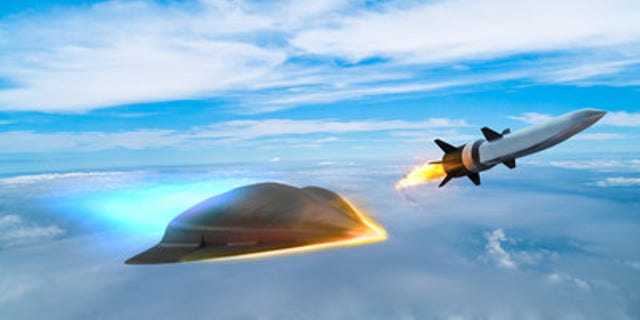No products in the cart.
The Pentagon is looking to Space War as an emerging method to counter seemingly unstoppable hypersonic weapons attacks, with early prototyping of satellite sensors and other tracking technology to more quickly find and “take out” weapons traveling more than five times the speed of sound.
“We have to work on sensor architecture, because they do maneuver and they are global, you have to be able to track them worldwide and globally. It does drive you towards a space architecture, which is where we’re going,” Navy Vice Admiral Jon Hill, director of the Missile Defense Agency, said in a Pentagon report.
The need to stop hypersonic weapons attacks is growing in significance and urgency, according to many senior Congressional and U.S. military leaders. Senate Armed Services Committee chairman Sen. Jim Inhofe, R-Okla., said China was in fact ahead of the United States regarding hypersonic weapons development.
“Last October, China paraded a hypersonic weapon, showing off a technology we don’t even have yet,” Inhofe said Thursday on the Senate floor, when talking about the need for a very strong 2021 military budget.
PENTAGON DEPLOYS NEW SUB-LAUNCHED, LOW-YIELD NUCLEAR MISSILE
The Missile Defense Agency and the Space Development Agency, Hill said, have already built a satellite prototype and plan to put up more new satellites to better track hypersonic attacks over the next few years.

Artist’s impression of hypersonic weapons.
(Raytheon)
“As ballistic missiles increase in their complexity … you’re going to be able to look down from cold space onto that warm earth and be able to see those,” he said. “As hypersonics come up and look ballistic initially, then turn into something else, you have to be able to track that and maintain track. In order for us to transition from indications and warning into a fire control solution, we have to have a firm track and you really can’t handle the global maneuver problem without space.”
Emerging Pentagon tactics are closely mirrored by current industry efforts which are also now exploring several categories of inquiry. This includes laser weapons, newer sensor networking, modifying existing interceptors or simply engineering new kill vehicles, Retired Lieutenant General Trey Obering, executive vice president at Booz Allen Hamilton, told Warrior in an interview earlier this year.. (Obering previously served as the Director of the Pentagon’s Missile Defense Agency).
Industry weapons developers explain that simply “tracking” approaching hypersonic weapons can be described as a key starting point when it comes to exploring these options. While there are of course a wide range of air, sea and land sensor technologies, tracking hypersonics will rely heavily upon satellites. Current satellite-mounted Spaced Based Infrared (SBIR) sensors can now detect the heat signature of an enemy ICBM or ballistic missile launch. The intent with SBIR is to transmit that information to land-based warning systems and instantly activate response protocols, but SBIR systems cannot themselves “track” the flight of a hypersonic weapon. However, the prospect of engineering a satellite, or group of satellites, with the technical capacity to track hypersonics—is very realistic.
PENTAGON APPROACHES MASSIVE NEW AI, MACHINE LEARNING BREAKTHROUGH
“We’ve got to be able to track them through their flight. We know their trajectory once they are out of the boost phase. You are going to have to track precisely enough so you can engage it with an interceptor,” Obering said in an interview with Warrior earlier this year. “We are collecting a lot of data on how this can be done,” he added.
A way to do this, Obering explained, would be to engineer a group of networked, lower-flying Very Low Earth Orbit satellites able to cover large swaths of territory. Although they cover more narrow areas than larger satellites and use more focused sensors, smaller satellites traveling closer to the earth can move faster, detect objects with greater fidelity in some cases and use advanced processing speeds to network key sensor data.
“We need enough satellites. We need to build a constellation that can track these weapons. We would have to have enough of them at the same altitudes,” Obering said.
Interestingly, airflow properties of hypersonic weapons can also provide a window through which to attack or destroy an enemy hypersonic weapon; hypersonic flight is not only complex but also extremely fragile, Obering explained.
Therefore, hypersonic weapons could also potentially be stopped by, as Obering put it, causing a “disruption in the airflow.” Changes in aerodynamics can break up forces such as lift, thrust and drag, Obering said.
CLICK HERE TO GET THE FOX NEWS APP
“These forces are all in balance. When you are going fast there is a small margin in those forces. A disruption can cause the entire vehicle to break up,” he explained.
Essentially, the idea is not to destroy the hypersonic weapon with an explosion, but rather cause an “instantaneous” angle change in the complex, interwoven mixture of air-flow variables. This, quite significantly, can cause an entire vehicle to break apart. A number of things could cause this, such as a laser, rupture of a booster, missile explosion in the vicinity of the weapon in-flight or some other kind of disruption.
Kris Osborn is the Managing Editor of Warrior Maven and The Defense Editor of The National Interest.


